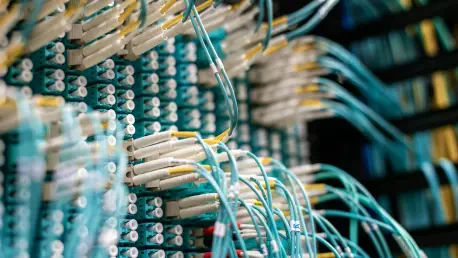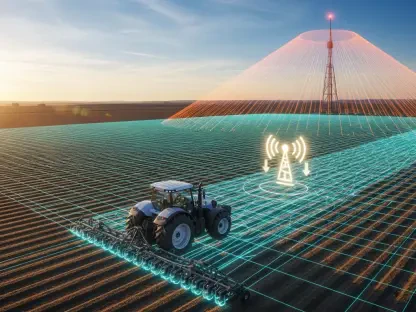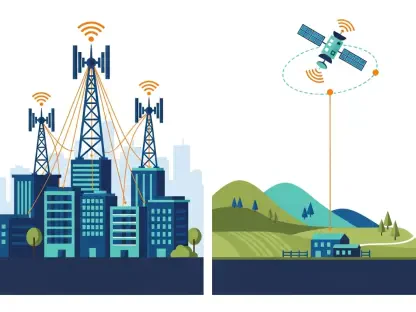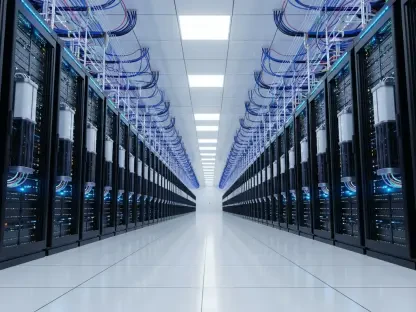In recent years, the tech industry has witnessed a dramatic resurgence in interest surrounding fiber optics technology due in large part to the unique challenges faced by data centers and the rapid rise of artificial intelligence (AI). As the digital landscape evolves, data centers are grappling with increasing demands on power and space—both of which are becoming scarce commodities amid the relentless growth in AI-driven processes. Amid this transformation, fiber optics is experiencing a renaissance, driven by next-generation technological advancements that significantly enhance data transmission capabilities. At the forefront of this revival is the groundbreaking hollow-core fiber technology, which exemplifies a paradigm shift in how data is transmitted and stored, promising to revolutionize the data center industry in the process.
The Role of Fiber Optics in Modern Data Centers
The role of fiber optics in modern data centers has become invaluable due to its potential to meet the unprecedented data throughput demands generated by AI workloads. Traditional copper cables simply cannot cope with the exponentially growing data requirements associated with AI computations, whereas fiber optics offer a high-capacity solution that facilitates rapid and efficient data transfer over vast distances. This capability allows data centers to expand further into less densely populated areas, effectively decoupling their physical location from urban centers and reducing the burden on local infrastructure.
The introduction of hollow-core fiber technology marks a significant leap in this domain. Developed by companies like Relativity Networks, this technology utilizes an air-filled core to transmit light instead of a traditional glass one, facilitating data transfer rates approximately 50% faster than conventional options. This breakthrough allows for a considerable increase in efficiency without compromising latency, enabling data centers to operate at previously unattainable degrees of bandwidth and speed. Consequently, as AI continues to permeate every aspect of the tech industry, fiber optics—and hollow-core technology in particular—have cemented their position as indispensable to the future of data center operations.
Hollow-Core Fiber: A Game-Changer for Distance and Speed
The adoption of hollow-core fiber reflects a broader shift in technological strategy within data-centric industries, focusing on enhancing core capacity and network agility. Beyond just speed, this technology significantly impacts how we think about geographical constraints for data centers. With the ability to maintain high-speed data transfer over long distances, hollow-core fiber allows data centers to be strategically located far from populous areas, mitigating concerns about land constraints and obtrusive installations in urban environments.
This capability addresses a critical challenge: the need for land and power resources in proximity to large-scale data operations. As data centers continue to increase their footprint, land availability near central urban locations becomes more challenging to secure, often presenting environmental and regulatory hurdles. Hollow-core technology provides a viable solution by enabling data centers to relocate to closer to abundant and underutilized energy sources without suffering from increased latency or reduced performance. Particularly, it offers a pathway to tap into renewable energy sources, such as solar or wind power, located in remote regions, thus aligning with sustainable practices while meeting operational needs.
Strategic Expansion and Industry Collaboration
The emergence of hollow-core fiber has ignited strategic expansion efforts within the fiber optics industry. Companies like Relativity Networks have embarked on ambitious projects to commercialize this technology beyond its conception stage. Notably, the retrofitting of cable facilities in the Netherlands signifies a large-scale industrial effort to ramp up the production of hollow-core fibers, illustrating a transition from experimental setups to full-scale manufacturing. This growth is in direct response to the mounting demand from hyperscale data centers, which require cutting-edge solutions to harness the full potential of AI advancements.
Moreover, significant collaboration within the industry exemplifies the widespread belief in the transformative power of fiber optics technologies. Strategic partnerships with leading players in the telecom and data industries, like those spearheaded by Relativity Networks with entities ranging from tech giants to those in allied sectors, underscore the importance placed on fiber optics as a foundational element of modern data infrastructure. These alliances reflect a recognition of both the technological and commercial potential hollow-core fiber embodies, driving forward a collective effort to address the burgeoning global data appetite.
Investment in Fiber Optics Innovation
The surging interest in fiber optics innovation is underscored by substantial investments from major industry stakeholders aiming to capitalize on its prospective value. These innovations not only benefit data centers but also hold broader implications for telecommunications and digital infrastructure, promising to elevate the standards of connectivity globally. High-profile investments and development initiatives, such as those undertaken by Italian cable producer Prysmian, emphasize an eagerness to amplify production capabilities and support technological advancements in fiber optics.
The European market’s openness to importing novel technologies, as demonstrated through partnerships with American innovators, indicates an understanding of the competitive advantages hollow-core fibers offer. Despite facing stiff competition from established Chinese fiber manufacturers, collaborations within the transatlantic tech landscape signify a strategic alignment to foster and integrate breakthrough technologies that can reshape the competitive dynamics of data infrastructure solutions. Through this vibrant investment landscape, fiber optics play a critical role not only as a technological frontier but also as a lucrative market segment poised to experience exponential growth.
The Evolution of Fiber Optics as an Industry Staple
The recognition of fiber optics as an indispensable component of the modern data infrastructure ecosystem has evolved dramatically from being a niche technology to a core industry staple. The efficiency and performance advantages offered by hollow-core fibers have significantly altered the strategic planning and deployment approaches of data center operators worldwide. This trend toward adopting advanced fiber optics solutions is indicative of a broader paradigm shift toward more sustainable and technologically advanced infrastructure in the data sector.
As AI continues to grow as a dominant force, the role of fiber optics in facilitating seamless data integration and connectivity becomes more pronounced. The continued development and adoption of this technology represent a shift in how data infrastructures are conceived, designed, and implemented, prioritizing efficiency and sustainability. Consequently, the coming years promise to see fiber optics solidify their position within the core framework of global digital infrastructure, driving forward the next wave of innovation in data management and processing.
Future Considerations in Fiber Optics and Data Infrastructure
The transformative potential of fiber optics, particularly with innovations like hollow-core fiber, underscores the industry’s evolution toward more sophisticated, efficient, and environmentally mindful data solutions. As data centers navigate the complexities of growing AI and machine learning needs, adopting cutting-edge fiber technologies will be integral to maintaining competitive advantages. However, continual innovation, regulatory alignment, and global cooperation will determine how effectively these advances are harnessed to meet future demands.
Looking ahead, stakeholders within the fiber optics sector must focus on expanding research and development efforts, addressing any technological barriers that arise, and fostering cross-industry collaborations to drive fiber innovation. Moreover, considerations related to environmental impact and sustainable practices must remain at the forefront to align with broader global priorities and commitments. By strategically integrating advanced fiber optics solutions, the industry can anticipate a robust framework capable of supporting future digital growth while maintaining a commitment to sustainable practices. In this rapidly evolving landscape, remaining adaptive and forward-thinking is not just beneficial but essential for continued success.









